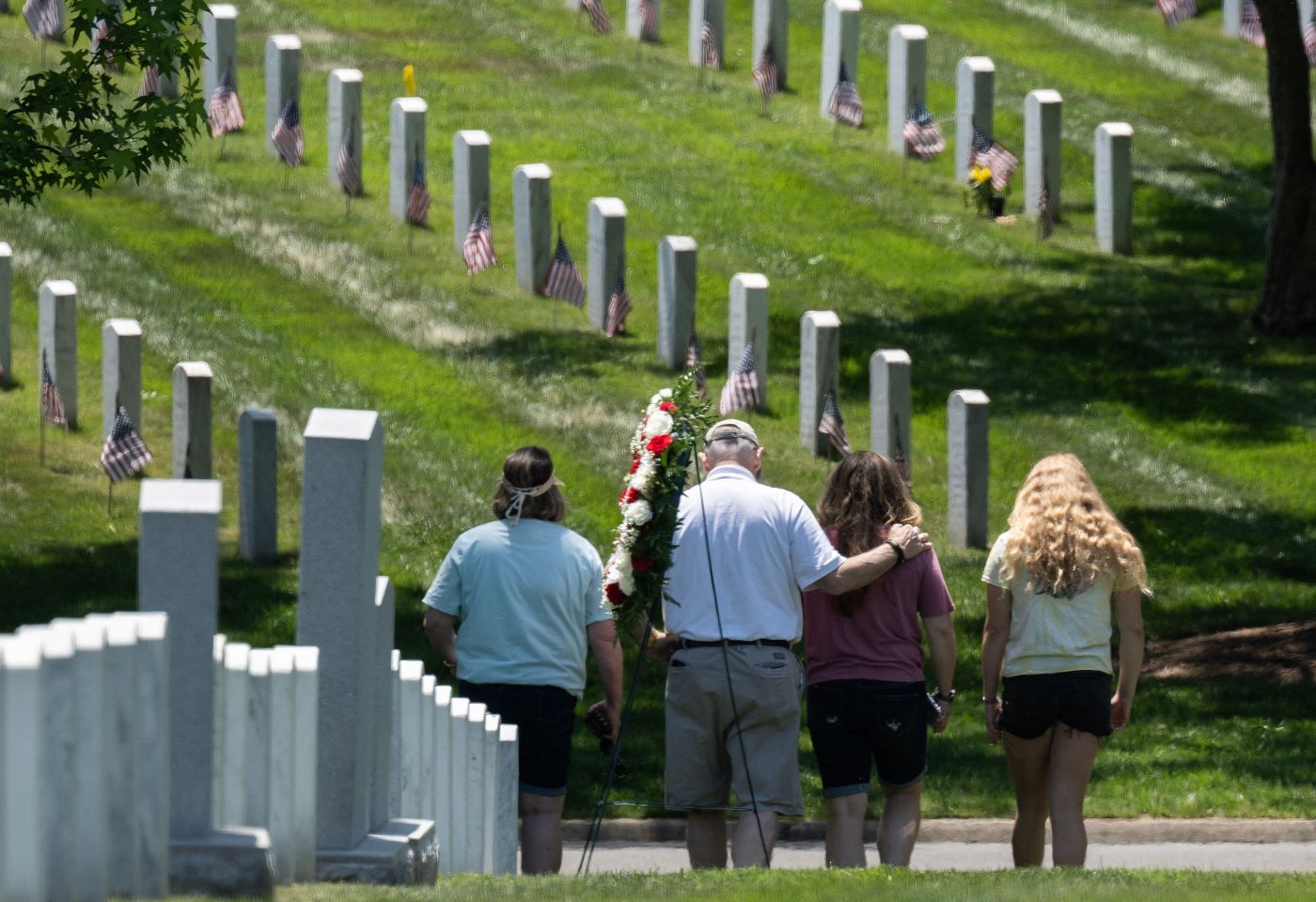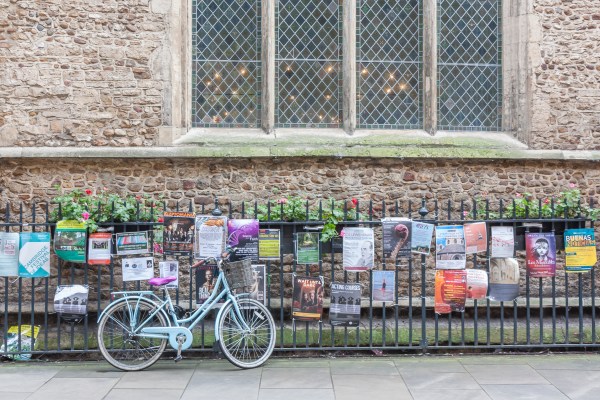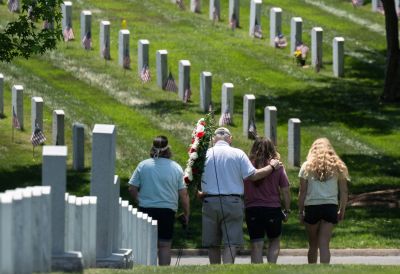Visiting Arlington National Cemetery on Memorial Day involves navigating a large crowd. Americans (and doubtless a few foreigners) of all ages and demographics clear security, pass through the visitor’s center, and enter the cemetery.
The vast majority of the crowd—at least 90 percent, in my estimation—continues past the center and walks up the hill to where the Tomb of the Unknowns stands majestic (along with other attractions—the Lee House and Kennedy’s eternal flame). The Unknowns is probably the best place in the cemetery to pay generic honor to America’s fallen. To borrow much better prose than my own, “It is altogether fitting and proper that we should do this.”
But a much smaller contingent chooses a different path. Usually in small groups, with plenty of spacing in contrast to the mass throng continuing up the hill, they take a left turn, walk across the generally flat ground and go through several road junctions before taking a second left turn, to a place on the right called Section 60. These persons are here to pay their respects in a much more personal manner—to be slightly irreverent, retail not wholesale.
Section 60 can be described as an accidental memorial. It is not as if someone planned a place where the hallowed dead of the “long wars” in Iraq and Afghanistan would be laid to rest. This was just bureaucratic inertia—Section 60 happened to be the place that, bluntly, had vacancies. As the number of war dead increased, Section 60 became the area in which such graves claimed a majority stake, “occupied by force,” in military terms. Other honored servicemembers are sprinkled throughout—passed from accident, disease, or age but entitled by service to placement in Arlington—but the war dead claimed primacy of place by raw numbers.
A decade or so ago, Section 60 looked like a pilgrimage site and trended distinctly younger. The past few years, the crowds have been smaller. We are aging, memory is fading, arguably wounds have healed as much as they ever will.
Activities vary widely. Some will spend much of the day in and around Section 60. Others will come to kneel or sit by a particular headstone for a few moments, then depart. The density of visitors varies with both time of day and weather, but in general it is a steady stream from early to late. Or at least such has been my experience whenever I arrive.
Thankfully—but also in a sense, lamentably—emotions have been tamed by the passage of years. We can, or should, remember the haunting photos of young widows and fiancées lying prostrate, as if to get closer to their late husband (or now never husband-to-be) through proximity. There are very few such displays these days. Some kneeling, lots of sitting, plenty of praying. But no deep, unassuageable grief.
There is something powerful about the proximity. While Washington’s nearby National Mall has deep, symbolic power, what happens in Section 60 at Arlington is different. As the saying goes, the residents of Section 60 are not yet truly dead because they are still remembered. And we go there to be present with the last physical link—or one of the last physical links—to these memories. Even if all that remains is “a few stray atoms brought back to the elements.”
Of course, not all our recent dead lie in Arlington. The cemetery at the U.S. Military Academy at West Point has an overweighted sample (the dead there outnumber the living), and others rest in cemeteries both national and private across the country. Families far from the capital understandably wish to inter their fallen close to home. But while this is, again, fitting and proper, without in any way diminishing the heroism of these servicemembers, the power of what they represent is diluted by the disbursement. Section 60 concentrates and distills all that.
There is an entire cohort—mostly, though not exclusively, those in uniform and their loved ones—for whom the events of 9/11 shifted the course of their lives forever. This was not a moment that was shared broadly, or at least not for more than a year or so. This is not anyone’s fault. As more than one commentator has observed, the demand made on the American people after 9/11 was to “go shopping.” For most Americans, the decades following 9/11 were defined by the 2008 financial crisis and the long bull market that followed. The wars that followed that fateful day were not universally experienced as such by the vast majority.
The burden instead fell on a select group: primarily servicemembers and their families, of course, after the victims and families of 9/11 itself. But it also fell on an elite—if you will—of military and development civilians who worked alongside and/or supported the “warfighters.” Nor should one forget the journalists who covered and often shared the dangers—and in a few tragic cases, the costs.
Interestingly, the visitors to Section 60 are, in my experience, almost evenly divided between men and women, despite the fact that the fallen are overwhelmingly male. While the public consciousness absorbs the stories of the women more deeply—Shannon Kent, Laura Walker, Ashley White—the hard numbers tell another story. More than 97.5 percent of the Iraq and Afghanistan war fatalities have been men. Of course, for every fallen male soldier there is a mother and often a wife or fiancé or girlfriend, just as for the women there are husbands and fathers. So while the parity makes sense, it is still notable, the brothers of the fallen mixing with the women who mourn them.
I go to Arlington only on Memorial Day, so I’m not certain what the “traffic” looks like on other days. And frankly, I’m not sure my friends there would still want me visiting at all anymore—I removed my “memorial bracelet” years ago on similar suspicions. It has been years, after all. Decades, in a growing number of cases. Would they want me to continue making this observance? Would they tell me I should be moving on and not be haunted by their deaths? I’ll assume they wouldn’t begrudge me a short drop-by on the holiday.
The limited circle of those who visit—and are generally near enough to visit—does occasionally, and perversely, make the holiday a reunion of sorts. I’ve never not run into a random acquaintance from the Long Wars, even though I tend not to stay very long. These encounters are usually interesting, sometimes awkward—contrary to popular opinion, not all of us involved in the Long Wars are friends. But nonetheless, shared loss tends to paper things over.
Barring illness, I’ll again be on that minor pilgrimage to Section 60 again. Perhaps at some point the murmurings that it’s been long enough will grow loud enough for me to listen. To leave the dead to their own quiet whispers … as they wait for us—we gathered observants on this day—to one day join them.
But not this year.






Please note that we at The Dispatch hold ourselves, our work, and our commenters to a higher standard than other places on the internet. We welcome comments that foster genuine debate or discussion—including comments critical of us or our work—but responses that include ad hominem attacks on fellow Dispatch members or are intended to stoke fear and anger may be moderated.
With your membership, you only have the ability to comment on The Morning Dispatch articles. Consider upgrading to join the conversation everywhere.